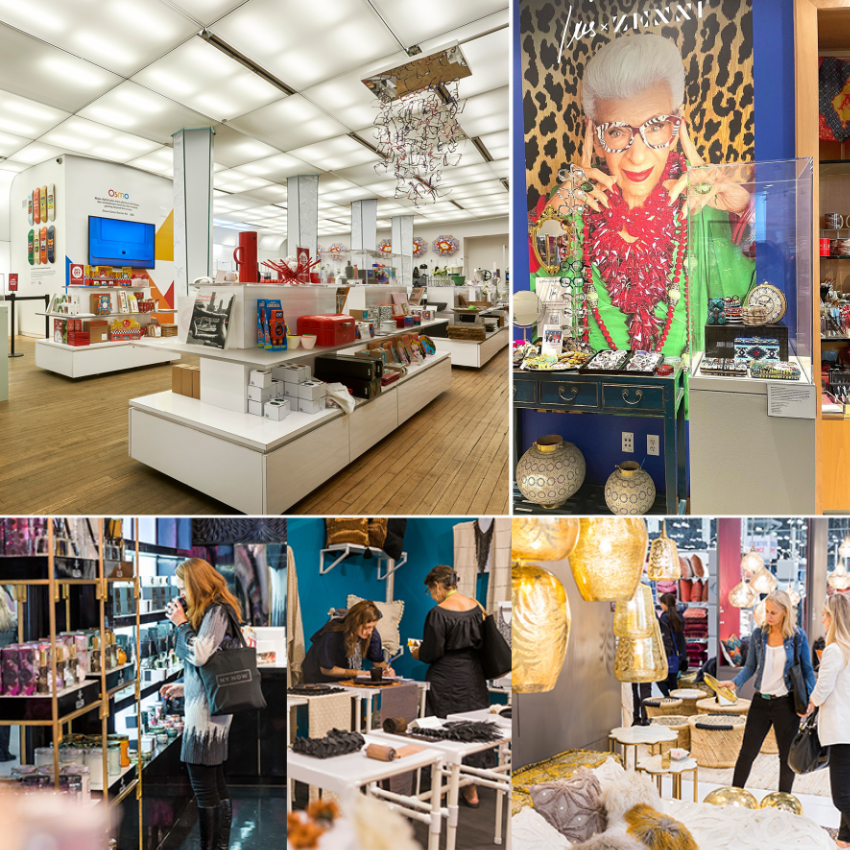The display greeting you at the doorway is a huge geode of crystal amethyst; the asking price is $2000. Behind it is a mannequin wearing an American Museum of Natural History T-shirt. Even for a museum store, the amethyst was impressive. “How many blocks have you sold?” I asked. “Quite a few,” the store manager answered. “You’d sell more if there was a sign next to it that said: Happy to ship.” “Done,” she said.
The New Museum Store
The museum store has gone through a seminal evolution over the past 20-some years. When the renovated Museum of Modern Art opened in 2004, the decision was made to separate the gift stores. The store in the main building housed the books, posters, and catalogs linked to the exhibits. Across the street was the stand-alone MoMA store. In their promotional material, the MoMA store describes its collaboration among the store buyers and the curatorial staff as good design, innovation in materials and technology, and a conceptual fit to museum’s collections and exhibits.
As with any retail enterprise, sustaining that first moment of wonder and awe on the fith-plus visit is the challenge. The museum store with a more frequent product rotation and unique offerings offers a better customer experience.
Across the museum world the concept of a gift store has gone from a gloried souvenir kiosk to a full-blown retail concept.
Museum shoppers are spread across the social and economic spectrum. Yes, the T-shirt crowd is looking for souvenirs, but there are also the affluent, sophisticated museum members and visitors who are willing to consider a broader cross section of products. As an example, the iconic Eames Lounge Chair can comfortably sit next to artist Kusama’s ceramic pumpkin, Kissy the stuffed penguin, Danish cookware, and a handblown bubble glass necklace—and speaks to a specific lifestyle. A designer chair fits very nicely into both the catalog and online worlds with artful photography and creative aesthetic memes. The product adjacencies can be clever as a key visual merchandising strategy. As a profit center for cultural and historic institutions, the gift store has become a real money generator.
Amplifying the Audience
MoMA’s important decision was to position the two stores so that shoppers do not necessarily have to be museum visitors. The museum industry across the country has picked up on that idea making the museum store a destination. Best in class are tthe Art Institute in Chicago, the Metropolitan in New York City (about 15 percent of the visitors that make it up the outside stairs don’t make it into the museum proper), and the Peabody Essex Museum in Salem, MA (one of my favorites and one of the few museum stores that has a dressing room). At the Florence Griswold Museum in Old Lyme, CT the museum store reports that 40+ percent of its traffic is comprised of customers who come only to visit the store. At a small museum, the main exhibit may change every few months, but member visits can be more frequent. The mantle of being a museum store is about curation that the museum members appreciate, which is why they return frequently. I, for one, do much of my holiday and birthday shopping in museum stores.
Gifts in Context
The Gift Show at the Jacob Javits Center is mind blowing—the scale, range, and number of countries of origin represented. My first visit 20 years ago was with a friend who had just started a marble factory in the Philippines where he found artisans who held the raw marble stones in their feet (rather than placing them on a table) and thus manipulated the marble to craft unique objects. He pointed out at the time that it was only the MoMA buyer that instantly recognized and valued the unique shapes his workers were able to extract. The MoMA store was one of his first clients.
The larger point here is that with museum stores, the buyers are as sophisticated as the customers. The trust extended to the store concept based on the visitors’ perception of the institution is unique. There is also an advantage to this more rarefied aesthetic; most retail chains and luxury brands can only deal with suppliers that are big enough at scale to fulfill their orders. The museum stores can cherry pick among craftpersons, artists, and artisans to choose limited and even exclusive offerings. For the smaller suppliers, the museum store is an important point of entry into the broader world of retail. Deals can get made and unique brands can become great success stories.
Yes, But…
A key question is whether the museum store can escape its immediate proximity to the cultural institution and be successful. Does the MoMA store in SoHo work? Are the Met Museum shops in airports sustainable? Another issue is how willing is the customer, particularly the tourist, to carry their purchases all over the city for the rest of the day. Free shipping is table stakes, and one of the classic mistakes that urban merchants make is waiting to tell the customer that they are happy to ship at the register when it’s too late. Another classic example the retail industry points to is the failure of The Toy R Us location in Times Square which generated huge traffic – with a low conversion ratio.
As with any retail enterprise, sustaining that first moment of wonder and awe on the fifth-plus visit is the challenge. I would argue that the museum store with a more frequent product rotation and unique offerings offers a better customer experience. The most popular staples are always there, but just as people visit museums to be inspired by the latest blockbuster show, museum stores have their own changing inventories that are specifically curated for return customers (who are their most profitable). Traditional retailers could learn a lesson or two here. Give your customers a reason to visit you…often.




